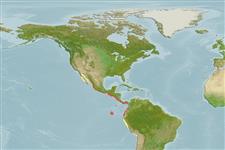Elasmobranchii (sharks and rays) >
Carcharhiniformes (Ground sharks) >
Sphyrnidae (Hammerhead, bonnethead, or scoophead sharks)
Etymology: Sphyrna: Probable misspelling of sphyra (Gr.), hammer, referring to their hammer-shaped heads (See ETYFish); corona: Latin for crown or halo, allusion not explained, probably referring to irregularly oval oculonarial expanse (See ETYFish).
Environment: milieu / climate zone / depth range / distribution range
Ecology
Marine; demersal; depth range 0 - 100 m (Ref. 121788). Tropical; 32°N - 19°S, 115°W - 69°W
Eastern Pacific: southern Mexico to northern Peru, probably including the Gulf of California.
Size / Weight / Age
Maturity: Lm ? range ? - ? cm
Max length : 92.0 cm TL male/unsexed; (Ref. 244)
Found on the continental shelf, presumably inshore. Viviparous, presumably with 2 young per litter. Probably the smallest species of hammerhead.
Life cycle and mating behavior
Maturity | Reproduction | Spawning | Eggs | Fecundity | Larvae
Viviparous, placental (Ref. 50449).
Compagno, L.J.V., 1984. FAO Species Catalogue. Vol. 4. Sharks of the world. An annotated and illustrated catalogue of shark species known to date. Part 2 - Carcharhiniformes. FAO Fish. Synop. 125(4/2):251-655. Rome: FAO. (Ref. 244)
IUCN Red List Status (Ref. 130435: Version 2024-1)
Threat to humans
Harmless
Human uses
Fisheries: subsistence fisheries
Tools
Special reports
Download XML
Internet sources
Estimates based on models
Preferred temperature (Ref.
123201): 15.9 - 25.2, mean 20.8 °C (based on 20 cells).
Phylogenetic diversity index (Ref.
82804): PD
50 = 0.5029 [Uniqueness, from 0.5 = low to 2.0 = high].
Bayesian length-weight: a=0.00347 (0.00153 - 0.00788), b=3.12 (2.93 - 3.31), in cm total length, based on LWR estimates for this (Sub)family-body shape (Ref.
93245).
Trophic level (Ref.
69278): 3.9 ±0.4 se; based on size and trophs of closest relatives
Resilience (Ref.
120179): Very Low, minimum population doubling time more than 14 years (Fec=2).
Fishing Vulnerability (Ref.
59153): High vulnerability (57 of 100).
Nutrients (Ref.
124155): Calcium = 41 [7, 209] mg/100g; Iron = 0.753 [0.193, 2.177] mg/100g; Protein = 19.5 [17.4, 21.6] %; Omega3 = 0.127 [0.054, 0.310] g/100g; Selenium = 50.5 [12.3, 139.9] μg/100g; VitaminA = 11.9 [4.4, 30.6] μg/100g; Zinc = 0.739 [0.361, 1.345] mg/100g (wet weight);
